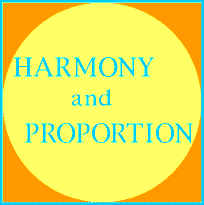
Pythagoras (6th century BC) observed that when the blacksmith struck his
anvil, different notes were produced according to the weight of the
hammer.
Number (in this case "amount of weight") seemed to govern musical
tone...
See if you can hear the sound in your imagination before it comes, by judging
from the proportions of the string lengths. The first one's easy.
Then
mouse-over the strings (-if you dont hear anything you'll have
to click, it depends on your set-up.)

